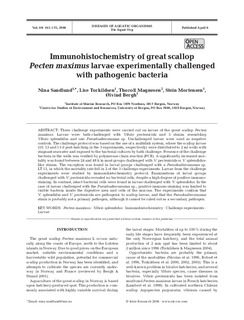Immunohistochemistry of great scallop Pecten maximus larvae experimentally challenged with pathogenic bacteria
Journal article, Peer reviewed
Permanent lenke
http://hdl.handle.net/11250/108878Utgivelsesdato
2006-04-06Metadata
Vis full innførselSamlinger
- Articles [3009]
Originalversjon
http://dx.doi.org/10.3354/dao069163Sammendrag
Three challenge experiments were carried out on larvae of the great scallop Pecten
maximus. Larvae were bath-challenged with Vibrio pectenicida and 5 strains resembling
Vibrio splendidus and one Pseudoalteromonas sp. Unchallenged larvae were used as negative
controls. The challenge protocol was based on the use of a multidish system, where the scallop larvae
(10, 13 and 15 d post-hatching in the 3 experiments, respectively) were distributed to 2 ml wells with
stagnant seawater and exposed to the bacterial cultures by bath challenge. Presence of the challenge
bacteria in the wells was verified by polymerase chain reaction (PCR). A significantly increased mortality
was found between 24 and 48 h in most groups challenged with V. pectenicida or V. splendiduslike
strains. The exception was found in larval groups challenged with a Pseudoalteromonas sp.
LT 13, in which the mortality rate fell in 2 of the 3 challenge experiments. Larvae from the challenge
experiments were studied by immunohistochemistry protocol. Examinations of larval groups
challenged with V. pectenicida revealed no bacterial cells, despite a high degree of positive immunostaining.
In contrast, intact bacterial cells were found in larvae challenged with V. splendidus. In the
case of larvae challenged with the Pseudoalteromonas sp., positive immuno-staining was limited to
visible bacteria inside the digestive area and cells of the mucosa. The experiments confirm that
V. splendidus and V. pectenicida are pathogenic to scallop larvae, and that the Pseudoalteromonas
strain is probably not a primary pathogen, although it cannot be ruled out as a secondary pathogen.
